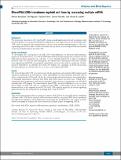| dc.contributor.author | Bousquet, Marina | |
| dc.contributor.author | Nguyen, Diu | |
| dc.contributor.author | Chen, Cynthia | |
| dc.contributor.author | Shields, Lauren | |
| dc.contributor.author | Lodish, Harvey F | |
| dc.date.accessioned | 2013-08-12T18:31:58Z | |
| dc.date.available | 2013-08-12T18:31:58Z | |
| dc.date.issued | 2012-06 | |
| dc.date.submitted | 2012-04 | |
| dc.identifier.issn | 0390-6078 | |
| dc.identifier.issn | 1592-8721 | |
| dc.identifier.uri | http://hdl.handle.net/1721.1/79831 | |
| dc.description.abstract | Background: We previously described a t(2;11)(p21;q23) chromosomal translocation found in patients with myelodysplasia or acute myeloid leukemia that leads to over-expression of the microRNA miR-125b, and we showed that transplantation of mice with murine stem/progenitor cells overexpressing miR-125b is able to induce leukemia. In this study, we investigated the mechanism of myeloid transformation by miR-125b.
Design and Methods: To investigate the consequences of miR-125b over-expression on myeloid differentiation, apoptosis and proliferation, we used the NB4 and HL60 human promyelocytic cell lines and the 32Dclone3 murine promyelocytic cell line. To test whether miR-125b is able to transform myeloid cells, we used the non-tumorigenic and interleukin-3-dependent 32Dclone3 cell line over-expressing miR-125b, in xenograft experiments in nude mice and in conditions of interleukin-3 deprivation. To identify new miR-125b targets, we compared, by RNA-sequencing, the transcriptome of cell lines that do or do not over-express miR-125b.
Results: We showed that miR-125b over-expression blocks apoptosis and myeloid differentiation and enhances proliferation in both species. More importantly, we demonstrated that miR-125b is able to transform the 32Dclone3 cell line by conferring growth independence from interleukin-3; xenograft experiments showed that these cells form tumors in nude mice. Using RNA-sequencing and quantitative real-time polymerase chain reaction experiments, we identified multiple miR-125b targets. We demonstrated that ABTB1, an anti-proliferative factor, is a new direct target of miR-125b and we confirmed that CBFB, a transcription factor involved in hematopoiesis, is also targeted by miR-125b. MiR-125b controls apoptosis by down-regulating genes involved in the p53 pathway including BAK1 and TP53INP1.
Conclusions: This study demonstrates that in a myeloid context, miR-125b is an oncomiR able to transform cell lines. miR-125b blocks myeloid differentiation in part by targeting CBFB, blocks apoptosis through down-regulation of multiple genes involved in the p53 pathway, and confers a proliferative advantage to human and mouse myeloid cell lines in part by targeting ABTB1. | en_US |
| dc.description.sponsorship | Leukemia & Lymphoma Society of America | en_US |
| dc.description.sponsorship | National Institutes of Health (U.S.) (NIH grant DK068348) | en_US |
| dc.description.sponsorship | National Institutes of Health (U.S.) (NIH grant 5P01 HL066105) | en_US |
| dc.language.iso | en_US | |
| dc.publisher | Ferrata Storti Foundation | en_US |
| dc.relation.isversionof | http://dx.doi.org/10.3324/haematol.2011.061515 | en_US |
| dc.rights | Creative Commons Attribution 3.0 | en_US |
| dc.rights.uri | http://creativecommons.org/licenses/by/3.0/ | en_US |
| dc.source | Ferrata Storti Foundation | en_US |
| dc.title | MicroRNA-125b transforms myeloid cell lines by repressing multiple mRNA | en_US |
| dc.type | Article | en_US |
| dc.identifier.citation | Bousquet, M., D. Nguyen, C. Chen, L. Shields, and H. F. Lodish. MicroRNA-125b Transforms Myeloid Cell Lines by Repressing Multiple mRNA. Haematologica 97, no. 11 (November 2, 2012): 1713-1721. | en_US |
| dc.contributor.department | Massachusetts Institute of Technology. Department of Biology | en_US |
| dc.contributor.department | Whitehead Institute for Biomedical Research | en_US |
| dc.contributor.mitauthor | Lodish, Harvey F. | en_US |
| dc.contributor.mitauthor | Marina Bousquet | en_US |
| dc.contributor.mitauthor | Nguyen, Diu | en_US |
| dc.contributor.mitauthor | Chen, Cynthia | en_US |
| dc.contributor.mitauthor | Shields, Lauren | en_US |
| dc.relation.journal | Haematologica | en_US |
| dc.eprint.version | Final published version | en_US |
| dc.type.uri | http://purl.org/eprint/type/JournalArticle | en_US |
| eprint.status | http://purl.org/eprint/status/PeerReviewed | en_US |
| dspace.orderedauthors | Bousquet, M.; Nguyen, D.; Chen, C.; Shields, L.; Lodish, H. F. | en_US |
| dc.identifier.orcid | https://orcid.org/0000-0002-7029-7415 | |
| mit.license | PUBLISHER_CC | en_US |
| mit.metadata.status | Complete | |
